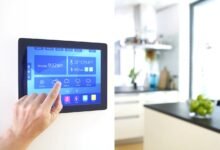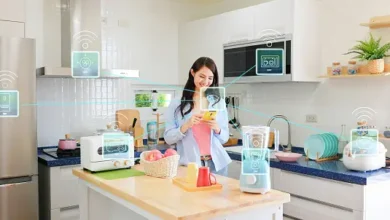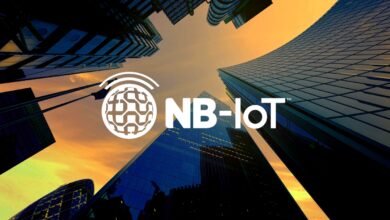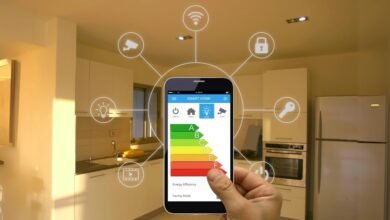How Smart Home Technology Transforms Your Living Experience
This article explores the profound impact of smart home technology, delving into its applications, benefits, and future potential

Smart home technology has emerged as a transformative force, redefining the way we interact with our living spaces. From intelligent thermostats that learn your habits to voice-activated assistants that streamline daily tasks, these innovations are not just conveniences but catalysts for a more efficient, secure, and sustainable lifestyle. This article explores the profound impact of smart home technology, delving into its applications, benefits, and future potential, while addressing the questions and curiosities of homeowners eager to embrace this revolution.
The Evolution of Smart Homes
The concept of a smart home, once a futuristic fantasy depicted in science fiction, has become a tangible reality. Early home automation systems, like those introduced in the 1970s with X10 protocols, allowed basic control of lighting and appliances. However, these systems were clunky and limited. Today, advancements in Internet of Things (IoT) technology, artificial intelligence, and cloud computing have propelled smart homes into a new era. Companies like Amazon, Google, and Apple have developed ecosystems—such as Alexa, Google Home, and HomeKit—that integrate devices seamlessly, creating interconnected environments that anticipate and respond to user needs.
This evolution is driven by the growing accessibility of high-speed internet and affordable smart devices. For instance, smart speakers like the Amazon Echo, introduced in 2014, have become household staples, with over 200 million units sold globally by 2023, according to Statista. These devices serve as central hubs, connecting everything from lighting systems to security cameras, making smart homes more intuitive and user-friendly than ever.
Enhancing Convenience Through Automation
One of the most immediate benefits of smart home technology is the unparalleled convenience it offers. Imagine waking up to a home that has already adjusted the thermostat to your preferred temperature, opened the blinds to let in natural light, and started brewing your morning coffee—all without you lifting a finger. Devices like the Nest Learning Thermostat adapt to your schedule, optimizing energy use while maintaining comfort. Similarly, smart plugs, such as those from TP-Link, allow you to control any plugged-in device remotely, turning a traditional lamp into a smart one with minimal effort.
Voice assistants have further simplified daily routines. By issuing commands to devices like Google Nest or Siri, you can set reminders, play music, or even order groceries without touching a screen. For busy professionals or parents, this automation reduces mental load, freeing up time for more meaningful activities. Moreover, smart home apps, such as Samsung’s SmartThings, provide centralized control, allowing you to manage devices from anywhere in the world, whether you’re at work or on vacation.
Boosting Energy Efficiency and Sustainability
Smart home technology is a powerful ally in the quest for sustainability. Energy consumption is a pressing concern, with residential buildings accounting for nearly 20% of global energy use, according to the International Energy Agency. Smart devices address this by optimizing resource usage. For example, smart thermostats like Ecobee analyze occupancy patterns and weather forecasts to adjust heating and cooling, potentially reducing energy bills by up to 23%, as reported by Energy Star.
Lighting systems, such as Philips Hue, use LED technology and motion sensors to ensure lights are only on when needed. These systems can be programmed to dim during peak sunlight hours or turn off when a room is unoccupied, further conserving energy. Beyond individual devices, smart home platforms integrate with renewable energy sources, like solar panels, to prioritize clean energy usage. Companies like Tesla, with their Powerwall and solar roof solutions, enable homeowners to store and manage solar energy, reducing reliance on fossil fuels and contributing to a greener planet.
Strengthening Home Security
Security is a top priority for homeowners, and smart home technology offers robust solutions that surpass traditional methods. Smart security systems, such as those from Ring or Arlo, combine high-definition cameras, motion detectors, and two-way audio, allowing real-time monitoring from your smartphone. If an intruder is detected, you receive instant alerts, and some systems even integrate with local law enforcement for rapid response.
Smart locks, like those from August or Yale, eliminate the need for physical keys, offering keyless entry through PIN codes or biometric scans. These locks can be programmed to grant temporary access to guests or service providers, ensuring you maintain control over who enters your home. Additionally, smart doorbells with facial recognition, such as Google’s Nest Doorbell, can identify familiar faces, adding an extra layer of personalization and security. By integrating these devices with platforms like Amazon’s Ring Home, you create a comprehensive security network that protects your home 24/7.
Improving Accessibility for All
Smart home technology is a game-changer for individuals with disabilities or mobility challenges. Voice-activated systems empower users to control their environment without physical effort. For example, someone with limited mobility can use Alexa to adjust lighting, open doors, or even operate motorized blinds. Companies like Control4 specialize in custom solutions that integrate accessibility-focused devices, such as smart wheelchairs or voice-controlled appliances, into cohesive systems.
For the elderly, smart home technology supports independent living. Sensors from brands like Lively can monitor daily activities, alerting caregivers if unusual patterns, such as a fall, are detected. Smart medication dispensers, like those from Hero, ensure timely medication intake with automated reminders and dispensing, reducing the risk of missed doses. These innovations not only enhance quality of life but also provide peace of mind for families, knowing their loved ones are safe and supported.
Personalizing Your Living Space
The ability to customize your home environment is a hallmark of smart technology. Smart lighting systems allow you to adjust color temperatures to suit your mood—bright white for productivity or warm amber for relaxation. Companies like Nanoleaf offer modular light panels that double as decorative art, syncing with music or movies for an immersive experience. Similarly, smart blinds from Somfy can be programmed to align with your circadian rhythm, opening at sunrise to promote healthy sleep cycles.
Entertainment systems have also been transformed. Smart TVs from Samsung or LG integrate with streaming services and voice assistants, enabling seamless content discovery. For audiophiles, multi-room audio systems like Sonos deliver synchronized sound across your home, controlled via a single app. These personalized touches make your home not just a place to live but a reflection of your lifestyle and preferences.
Addressing Privacy and Security Concerns
While the benefits of smart home technology are undeniable, concerns about privacy and cybersecurity are valid. High-profile data breaches, such as the 2019 Ring camera hack, have raised questions about the safety of connected devices. To mitigate risks, manufacturers are prioritizing encryption and multi-factor authentication. For example, Apple’s HomeKit uses end-to-end encryption, ensuring data remains secure. Homeowners can further protect themselves by using strong passwords, updating firmware regularly, and disabling unnecessary features, such as remote access when not needed.
Transparency is also improving. Companies like Google now provide detailed privacy policies, explaining how data is collected and used. Choosing devices from reputable brands and reviewing their security certifications, such as those from the IoT Security Foundation, can further enhance trust. By taking these precautions, you can enjoy the benefits of a smart home without compromising your privacy.
The Future of Smart Home Technology
The future of smart homes is brimming with possibilities. Artificial intelligence is becoming more sophisticated, enabling devices to predict user needs with greater accuracy. For instance, Google’s DeepMind is exploring AI-driven energy management systems that could optimize entire neighborhoods, not just individual homes. Meanwhile, 5G technology promises faster, more reliable connections, reducing latency and enabling real-time interactions with devices.
Emerging trends, such as augmented reality (AR) integration, could allow homeowners to visualize smart home setups before installation, using tools like IKEA’s AR app. Additionally, advancements in robotics, such as Amazon’s Astro robot, hint at a future where autonomous assistants handle household chores, from vacuuming to package delivery. As these technologies mature, smart homes will become even more intuitive, seamlessly blending into our lives.
Overcoming Barriers to Adoption
Despite its advantages, smart home technology faces barriers to widespread adoption. Cost remains a significant hurdle, with comprehensive systems like Crestron or Savant requiring substantial investment. However, affordable options from brands like Wyze and Kasa are making smart homes accessible to budget-conscious consumers. Compatibility issues also persist, as devices from different manufacturers may not integrate smoothly. Platforms like Matter, a universal smart home standard backed by Apple, Google, and Amazon, aim to solve this by ensuring cross-device compatibility.
Lack of technical expertise can also deter adoption. To address this, companies are simplifying setup processes, with plug-and-play devices and user-friendly apps. Online resources, such as CNET’s smart home guides or Wirecutter’s product reviews, provide step-by-step advice for beginners. By demystifying the technology, these resources empower more people to embrace smart home solutions.
Integrating Smart Homes into Everyday Life
Adopting smart home technology doesn’t require a complete overhaul. Start with a single device, like a smart speaker or thermostat, and gradually expand your ecosystem. For example, pairing a smart bulb with a motion sensor can enhance both convenience and energy efficiency. As you become comfortable, integrate additional devices, such as security cameras or smart locks, to create a cohesive system tailored to your needs.
Community initiatives are also driving adoption. Cities like San Diego are implementing smart city projects that integrate home automation with urban infrastructure, such as smart grids that optimize energy distribution. These efforts demonstrate how smart home technology can scale beyond individual households, contributing to smarter, more sustainable communities.
FAQ: Common Questions About Smart Home Technology
What is smart home technology?
Smart home technology refers to devices and systems that connect via the internet to automate and control home functions, such as lighting, heating, security, and entertainment, often managed through apps or voice assistants.
How does smart home technology save energy?
Smart devices, like thermostats and lighting systems, optimize energy use by adjusting settings based on occupancy, schedules, and environmental conditions, reducing waste and lowering utility bills.
Is smart home technology secure?
While risks exist, choosing devices with strong encryption, like Apple’s HomeKit, and practicing good cybersecurity habits, such as using strong passwords, can significantly enhance security.
Can smart home technology help people with disabilities?
Yes, voice-activated systems and automated devices enable individuals with mobility challenges or disabilities to control their environment, promoting independence and accessibility.









